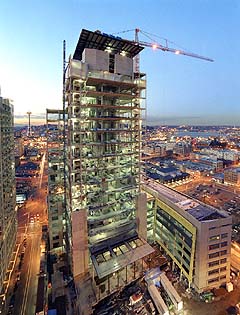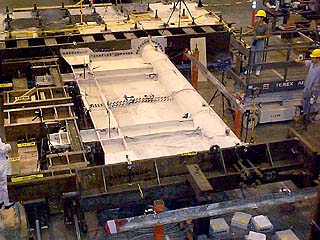|
Subscribe / Renew |
|
|
Contact Us |
|
| ► Subscribe to our Free Weekly Newsletter | |
| home | Welcome, sign in or click here to subscribe. | login |
Construction
| |
 |
September 23, 2004
Unique structural system braces courthouse
Magnusson Klemencic Associates

Photos courtesy of MKA
Engineers had to get creative to develop a structural system that could accommodate the 20-foot floor-to-floor height in the new courthouse. They used to a new approach that takes advantage of the compressive strength of concrete and the energy-absorbing properties of structural steel. |
In response to heightened security concerns after the Oklahoma City attack, the site plans for the new U.S. Federal Courthouse shifted from a location over Interstate 5 to a more secure site at the corner of Seventh Avenue and Stewart Street.
Since the building is located in a seismic zone, just miles from the Seattle fault line, special consideration was given to the earthquake-resisting system in this building.
A complicating factor is the high floor-to-floor heights needed for courtrooms. Conventional high-rise buildings have story heights of 12 to 13 feet. To provide appropriate courtroom ceiling heights, the floor-to-floor height needed to be 20 feet. This pushes the practical limits of application for many conventional structural systems.
Magnusson Klemencic Associates, the structural engineering firm for the project, worked with the design team to develop a unique structural system on the 22-story courthouse to meet public safety requirements.
The structural system
The building's composite pipe and steel plate shear wall system differs from conventional concrete walls or steel cross-braced systems that are typically seen in this region. This new approach takes advantage of the compressive strength of concrete, and the earthquake energy-absorbing properties of structural steel.
The structural system consists of steel plate wall panels, steel wide-flange beams and columns, and concrete-filled steel pipe columns. This is the first time this system has been used in any building.
Weathering earthquakes
Thin steel plates are located between concrete-filled pipe columns and conventional steel framing. The plates are free to locally "buckle" or bend in an earthquake, preventing damage to the surrounding framework that holds up the building. With every cycle of plate buckling and bending in an earthquake, the seismic forces are further resisted.
The steel pipe columns are filled with a special concrete that is more than twice as strong as conventional concrete, resulting in a very high-capacity column. The steel framing that is part of the shear wall core system uses special welded connections that were developed after the 1994 Northridge earthquake in California, and have been shown to have superior seismic performance.
The combination of the steel plate wall panels, composite concrete-filled pipe, and special welded connections results in a high-performance system.
Lighter than concrete
In addition to a high level of seismic performance, the structural system used in the courthouse has other advantages. For example, the use of steel is lighter than equivalent concrete structures, so the foundation is more efficient. Earthquake forces, which are directly proportional to the building's weight, are thereby reduced.
This system ultimately resulted in a structure that had a lower cost than all the other systems considered.
Testing the system

Researchers at the University of Cailfornia helped test a steel plate structural system that was used in the federal courthouse.
|
The objectives in developing the structural system included designing a building with a high level of seismic performance, minimizing system construction costs and incorporating architectural space planning.
The GSA examined this system in great detail during the design phase and enthusiastically embraced it. The GSA's structural engineering group was convinced of its merits after detailed review with NBBJ and MKA. In fact, the GSA was so intrigued by the possible benefits of this system, they sponsored scale testing to gain a better understanding of its anticipated seismic performance.
In August 2000, eight months prior to construction, a half-scale replica of this system was tested at the University of California. In the university's lab, jacks pushed and pulled with a force of 1.2 million pounds on the replica in a manner consistent with tests performed by the Federal Emergency Management Agency after the Northridge earthquake. The resulting performance exceeded all of the steel structural systems that are in the current building code.
Award-winning design
In May 2004, a year after the courthouse's steel structure was completed, MKA and the rest of the development team were presented with the 2004 Charles Pankow Award, the American Society of Civil Engineers' highest annual award for innovation.
The structural system has performed so well that GSA plans to use this system for a project in an even higher seismic region, at the new federal courthouse in Los Angeles.
GSA and NBBJ led an effort that demanded new answers to the increasingly challenging questions of seismic design. This system answers those questions in a way that will benefit seismic regions throughout the world.
Brian Dickson is a project manager at Magnusson Klemencic Associates. Jon Magnusson is the firm's chief executive officer.
Other Stories:
- Demanding project pulls engineers together
- Rethinking the courthouse from inside out
- Plaza offers an urban oasis


